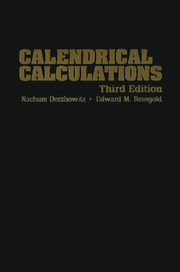Book contents
- Frontmatter
- Dedication
- Contents
- List of Frontispieces
- List of Figures
- List of Tables
- Abbreviations
- Mathematical Notations
- Preface
- Credits
- License and Limited Warranty and Remedy
- About the Cover
- 1 Calendar Basics
- I ARITHMETICAL CALENDARS
- II ASTRONOMICAL CALENDARS
- 13 Time and Astronomy
- 14 The Persian Calendar
- 15 The Bahá'í Calendar
- 16 The French Revolutionary Calendar
- 17 The Chinese Calendar
- 18 The Modern Hindu Calendars
- 19 The Tibetan Calendar
- 20 Astronomical Lunar Calendars
- Coda
- III APPENDICES
- Index
- Envoi
- About the Cover
16 - The French Revolutionary Calendar
Published online by Cambridge University Press: 05 February 2014
- Frontmatter
- Dedication
- Contents
- List of Frontispieces
- List of Figures
- List of Tables
- Abbreviations
- Mathematical Notations
- Preface
- Credits
- License and Limited Warranty and Remedy
- About the Cover
- 1 Calendar Basics
- I ARITHMETICAL CALENDARS
- II ASTRONOMICAL CALENDARS
- 13 Time and Astronomy
- 14 The Persian Calendar
- 15 The Bahá'í Calendar
- 16 The French Revolutionary Calendar
- 17 The Chinese Calendar
- 18 The Modern Hindu Calendars
- 19 The Tibetan Calendar
- 20 Astronomical Lunar Calendars
- Coda
- III APPENDICES
- Index
- Envoi
- About the Cover
Summary
Of the Republican calendar, the late John Quincy Adams said: “This system has passed away and is forgotten. This incongruous composition of profound learning and superficial frivolity, of irreligion and morality, of delicate imagination and coarse vulgarity, is dissolved.” Unfortunately the effects of this calendar, though it wasused for only about twelve years, have not passed away. It has entailed a permanent injury on history and on science.
—Joseph Lovering: Proceedings of the American Academy of Arts and Sciences, p. 350 (1872)The French Revolutionary calendar (Le Calendrier Républicain)was instituted by the National Convention of the French Republic in October 1793. Its epoch is R.D. 654,415, that is, Saturday, September 22, 1792 (Gregorian), the day of the autumnal equinox of that year and also the first day following the establishment of the Republic. The calendar went into effect on Sunday, November 24, 1793 (Gregorian) and wasused by the French until Tuesday, December 31, 1805 (Gregorian); on Wednesday, January 1, 1806 (Gregorian), the Revolutionary calendar was abandoned by Napoleonic edict and France reverted to the Gregorian calendar, but the Revolutionary calendar was used again during the “Paris Commune” of May 6–23, 1871 (Gregorian), an insurrection that occurred after the collapse of Napoleon III's Second Empire.
- Type
- Chapter
- Information
- Calendrical Calculations , pp. 239 - 246Publisher: Cambridge University PressPrint publication year: 2007



